
Image Credit: Pixabay
More Than Half Of Students In Minority Schools Are From Non-Minority Communities
Writer: Prattusa Mallik
A student of Journalism and Audio-Visual Communication, interested in words and silences alike, I aim to bring the narratives of the periphery to the centre, one story at a time. When not working, I'm usually caught reading, thinking, writing, watching Friends, or stargazing.
India, 17 Aug 2021 1:26 PM GMT
Editor : Madhusree Goswami |
A mountain girl trying to make it big in the city. She loves to travel and explore and hence keen on doing on-ground stories. Giving the crux of the matter through her editing skills is her way to pay back the journalism its due credit.
Creatives : Prattusa Mallik
A student of Journalism and Audio-Visual Communication, interested in words and silences alike, I aim to bring the narratives of the periphery to the centre, one story at a time. When not working, I'm usually caught reading, thinking, writing, watching Friends, or stargazing.
NCPCR chairperson has noted that several schools had registered themselves as minority institutions simply because they do not have to implement RTE.
The National Commission of Protection of Child Rights (NCPCR) has recommended to the government to bring all minority schools (including Madrasas) under the sphere of Right to Education (RTE) and Sarva Shiksha Abhiyan campaign. The recommendation came according to the report of a nationwide survey conducted on minority schools. NCPCR also supported reservation for minority community students in minority schools after finding out that many non-minority students have been studying in these schools.
To be specific, 62.50 per cent of students in minority schools hailed from non-minority communities. In Christian missionary schools, 74 per cent of students are from non-minority communities. The highest number of out-of-school children (1.1 crore) were from the Muslim community.
Reason Behind Recommendation
NCPCR Chairperson Priyank Kanoongo said, "The aim of the study was to assess how the 93rd Amendment, which exempts minority institutions from the otherwise mandatory provisions of Right to Education, has affected children belonging to minority communities and whether there has been a gap," reported The Indian Express. He further noted that several schools had registered themselves as minority institutions simply because they do not have to implement RTE.
However, he stated that Article 30 (which ensures the right of minorities to open their institutions for religious, linguistic, and cultural protection) could not contravene Article 21(A) (which protects the fundamental right to education of a child).
Therefore, the exemption must be reviewed as it deprives underprivileged children (belonging to minority communities) of education in these schools. Hence, the recommendation.
Also, only 8.76 per cent of students from such schools belong to economically and socially disadvantaged backgrounds, as these schools don't need to admit students from such backgrounds. This, too, had been happening because these minority schools are not under the purview of RTE.
Other Significant Findings
Another pertinent point that the report focuses is on how the numbers of schools are disproportionate. For example, Christians and Muslims constitute 2.47 per cent and 92.47 per cent of the minority population in West Bengal. In contrast, the numbers of Christian minority schools and Muslim minority schools in the state are 114 and two, respectively.
According to the report, minority schools cater to only 8 per cent of the minority population, despite a significant proportion of minority students being a part of the school-going age groups. Therefore, there should be specific guidelines about the minimum percentage of minority community students admitted to these institutions.
Also read: Transgender Persons Face Maximum Discrimination From Family: Study
 All section
All section














